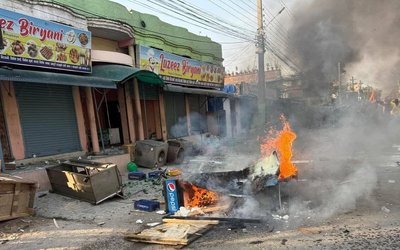More on News





The Chinese are here. And the biggest Chinese show in town was on Diwali when millions of made-in-China lamps and crackers lit up the Indian sky.
Divided by the Himalayas, India and China have always had a troubled relationship. Something has always been not right between the two nations. Besides the apparent reasons and the war, Sino-India relationship has been a victim of distrust. Hindi-Chini are bhai-bhai but they can’t see eye-to-eye.
This animosity between the two nations is set to be played on a bigger canvas with China growing rapidly and wanting to have global strategic depth commensurate with its economic might. From a fleet of fighter jets battle ready to the first aircraft carrier, Beijing wants the world to know that it has arrived. And, rightly so, considering that its economy is already world’s second biggest and is poised to overtake that of the US in less than a decade.
India is also on the race to gain a seat in the global high table but it is doing so on a different tangent from China. While China is world’s workshop, India has been its back office.
After some years of high growth, India has perceptibly slowed down a bit. No one wants to accept – least of all the government – that high GDP growth rates would be very difficult to achieve again, but the telltale signs are for all to see.
While most argue that the slowdown is due to policy paralysis, others argue that it is due to the general slowdown in global economy.
Certainly both India and China are standing at a very important crossroad in their individual and to some extent entwined relationship.
What adds to the gravitas is the transition in China from President Hu Jintao to his successor Xi Jinping. Although the change in leadership of the Communist Party has been in the works for a while and was predictable, the situation is far from comfortable for the party after the emergence of high-profile corruption cases involving its top leaders.
Also, the party has to meet the aspirations of its billion plus population that has lived long enough on the opium of high growth to go back to more austere ways. The divide between the rich and the poor is stark in China and may aggravate further if growth slumps as the hardest hit in such a scenario would be the poor.
India also faces a similar quandary and is also equally unprepared for a low growth phase.
Facing common challenges the two nations should have historically worked together for the common good but that has not been the case. Even before the first Chinese troops set foot in India in 1962, the relationship between the two nations has been less than warm.
And, it is intriguing that two of the world’s oldest and greatest civilisations, despite being in close proximity to each other, never interacted the way they should. Both nations have lived and grown in their own silos for most part of their history and the mould seems to have set hard.
India and China engage at multiple levels, yet suspicions of each other are at an all time high. And it would be naïve to think that it is only about the 1962 war or the border.
China has subtly and at times with brazenness displayed its intent to keep the China-India friction story going. Be it the stapled visa issue, railway line to Nepal, arming Sri Lanka or backing India’s bête noire Pakistan, Chinese love to be on the other side when it comes to matters related to India.
New Delhi also has no misgivings about the Chinese position. As West Bengal Governor and former National Security Advisor M K Narayanan recently said, India and China are to an extent destined by geography to be "rivals" and Beijing`s increasing assertiveness on its part while dealing with disputes is "most disconcerting".
However, given the growing stature of both nations, they can’t avoid each other anymore. Be it the duel to secure energy sources or control trade routes through the Indian Ocean, India and China are increasingly finding themselves on opposite sides and they realise the situation won’t change anytime soon.
On the bigger geo-political sphere, while China wants India to be confined to SAARC as it goes about in its mission to be the next superpower with influence not just in Asia-Pacific but also across the globe, New Delhi sees itself as an important player in Asia and beyond.
Meanwhile, the US has been edging India to take on China in Asia-pacific as part of its own game plan to confine China to region and not throw its hat in the global game.
Let’s face it, we can’t avoid China anymore. With the US and the EU slowing down, the next growth push would come from the East and the Elephant would have to face the dragon.
But the face-off need not be antagonistic; the room is big enough to hold both. The new leadership of China will, most probably, meet Prime Minister Manmohan Singh as part of the East Asia Summit in Cambodia.
The opportunity before the two sides is welcoming and can go far beyond the Chinese crackers provided both sides see reason and sense in trusting each other rather than playing the game as per the rules set by Uncle Sam.
Znews





